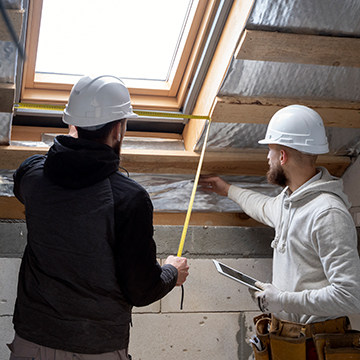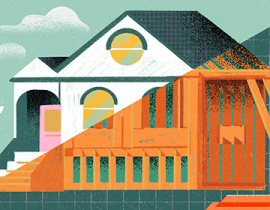- Home
- Blog
- Tips & Advice
- Identify Structural Defects in a Home
Identify Structural Defects in a Home
Imagine moving into your dream home, sunlight streaming through the windows, fresh paint on the walls, everything seemingly perfect. Then, a few months later, you notice cracks creeping along the ceiling, doors that no longer close properly, or strange damp patches on the walls. What seemed like minor inconveniences could be early warning signs of much bigger trouble: house structure problems and underlying structural defects.
But how to identify structural defects in a home before it becomes a money pit? Let’s break it down.
What is Considered a Structural Defect in a Home?
 In simple terms, a structural defect is any issue that affects the core integrity or stability of a property. This includes cracks in the foundation, misaligned roofs, unstable walls, or weakened load-bearing components. Unlike cosmetic flaws, these aren't just unpleasant—they can compromise the safety of the entire building.
In simple terms, a structural defect is any issue that affects the core integrity or stability of a property. This includes cracks in the foundation, misaligned roofs, unstable walls, or weakened load-bearing components. Unlike cosmetic flaws, these aren't just unpleasant—they can compromise the safety of the entire building.
This is why home inspection for structural damage isn't just an option; it's a necessity, especially when you're buying or handing over a property.
Common Structural Problems in Houses You Should Know
Every home, whether old or newly built, can suffer from structural defects. Some of the most common structural problems in houses include:
Foundation Cracks and Settlement: Diagonal cracks on walls, sloping floors, or doors that won’t close properly may indicate foundation movement.
Roofing and Ceiling Structural Issues: Leaks, sagging rafters, or daylight peeking through the attic? Those are major red flags.
Poor Drainage and Foundation Damage: Blocked gutters or inadequate drainage can slowly eat away at the foundation, leading to instability. Preventing foundation cracks and waterproofing basement walls are essential steps to protect your home from long-term moisture-related damage.
Electrical Faults and Fire Risks: Outdated or poorly installed electrical systems can cause short circuits—or worse, fires.
Moisture and Damp: Bubbling paint, musty odors, or visible mold may point to water infiltration. Over time, this can corrode structural elements and affect health.
Still wondering what is considered a defect in a home inspection? Essentially, anything that reduces the building’s ability to perform its intended function, whether it’s keeping the roof above your head or safely distributing loads to the ground.
Structural Issues in Old Homes vs. Defects in New Build Homes
While structural issues in old homes often stem from age and wear—think weathered roofs or sinking foundations, defects in new build homes usually result from poor workmanship, rushed construction, or low-quality materials. Just because it’s new doesn’t mean it’s flawless.
If you're still torn between buying an older home or building one from the ground up, read up on our build vs buy home content to weigh the pros and cons realistically.
Either way, a professional property inspection service can spot issues before they turn into major repairs.
Why Structural Defects Matter (More Than You Think)
 Let’s be honest, no one enjoys the thought of repairs. But ignoring structural defects in homes can lead to:
Let’s be honest, no one enjoys the thought of repairs. But ignoring structural defects in homes can lead to:
- Safety hazards from structural defects, such as ceiling collapse or electrical fires
- Long-term cost of fixing structural defects, which can spiral quickly
- Reduction in property value and insurance complications
Worse yet, some defects stay hidden until they cause visible damage or even physical injury. That’s why knowing how drainage affects home structure or recognizing signs of roof structure failure early on makes all the difference.
How to Spot Warning Signs Early
If you’re unsure what is considered a major defect in a home inspection, start with this informal house defect checklist:
- Cracks wider than 3mm, especially those that run diagonally
- Uneven or sloping floors
- Doors/windows that stick or swing open by themselves
- Damp patches, especially near ceilings or floors
- Flickering lights or frequent breaker trips
- Warped or sagging rooflines
- Mold or condensation between windowpanes
- Gaps where walls meet floors or ceilings
These aren't just aesthetic flaws—they might be signs of deeper structural issues. It’s worth keeping a running house defect list and seeking expert advice when in doubt.
Gutters, Drainage & Prevention
It might sound boring, but water is one of your home’s biggest enemies. Blocked gutters or poorly designed downpipes can pool water around your foundation, leading to slow but serious erosion. That’s why knowing how drainage affects home structure is critical.
Regular maintenance of these components isn’t glamorous, but it’s effective.
Cracked Walls and Uneven Floors: Are They Dangerous?
Absolutely. These often indicate underlying stress in the load-bearing parts of your home. Ignoring them can lead to increased instability, making repair work far more expensive (and urgent). It’s a common misconception that “a little crack is no big deal”—until it widens or spreads.
When You Need an Expert
Hiring a licensed inspector to conduct a home defect inspection can help catch issues before they turn into expensive disasters. Whether you’re buying a home or just moved in, getting a house defect report can reveal hidden flaws not visible during a casual walkthrough.
 Also, don’t forget the benefit of structural defects insurance. It won’t prevent damage, but it could save your wallet when problems arise—especially for new properties within their defect liability period.
Also, don’t forget the benefit of structural defects insurance. It won’t prevent damage, but it could save your wallet when problems arise—especially for new properties within their defect liability period.
Structural engineer inspection cost may vary depending on the property's size and location, but it's often a worthwhile investment compared to potential repair expenses. Hiring a building inspector for structural issues ensures a detailed evaluation of the foundation, load-bearing walls, and roof structure, helping you avoid costly surprises down the line.
The Value of Early Inspection
Here’s the thing: an early and thorough inspection doesn’t just catch problems—it prevents escalation. By the time a structural crack becomes visible, the issue might have been growing for months, maybe years.
Early professional property inspection services use tools like moisture meters, infrared cameras, and laser levels to detect issues before your eyes can. Think of it as an investment, not a cost.
Final Tips to Protect Your Home Investment
To wrap up, understanding what is considered a structural defect in a home and taking proactive steps can save you thousands—not to mention stress. Whether you’re a first-time buyer or a seasoned investor, a well-executed home defect inspection and house defect checklist are your best allies.
If you’re still unsure how to get started, seek a certified professional and ask for a detailed house defect report. From electrical faults and fire risks to foundation cracks and settlement, the earlier you act, the safer and more stable your home will be.
Your dream home should be just that a dream, not a structural nightmare.










